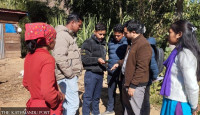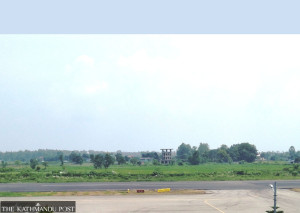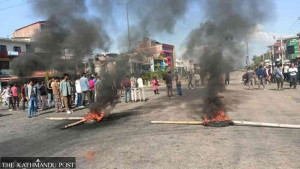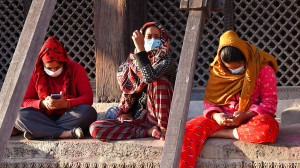Wed, Dec 3, 2025
National
Child marriage, once rampant, sees decline in a rural community
A little over two years ago, Suraj Mali got married. He was 10.Today, when asked about his wife, Mali cannot summon up an answer. He doesn’t even know her name. He says that his father made him marry the girl without his consent. Like most people from the Dome community in the region, Mali has never been to school.
bookmark
Shiva Puri
Published at : December 27, 2018
Updated at : December 27, 2018 19:06
Rautahat
A little over two years ago, Suraj Mali got married. He was 10.
Today, when asked about his wife, Mali cannot summon up an answer. He doesn’t even know her name. He says that his father made him marry the girl without his consent. Like most people from the Dome community in the region, Mali has never been to school.
During the Post’s recent visit to the community, Mali was sitting alone at his home in Dhamaura Chowk, about 25km east of district headquarters Gaur, while his parents were away for work.
Mali said he got married according to the Dome culture. The bride’s house is in Pipara Bazaar, nearly 40 km away from his home. His wife, Mamata, was just seven years old when they tied the knot. On the day of their marriage, Mamata was taken to Mali’s house but was returned to her parents’ house the next day.
“I am still too young now and I don’t know much about life,” Mali told the Post. “I will bring my wife back home once we both grow up.”
According to the recently amended civil code, the minimum age for marriage in Nepal for both women and men is 20. Although the country abolished child marriage in 1963, the practice is still rampant, especially in some of the most rural areas, even as human rights groups regularly blame the government for failing to take sufficient steps to end the practice.
Mali’s father, Dipendra, admits to getting his son married at a very young age but told the Post that in hindsight, he thinks it was a very bad idea.
“We performed his wedding three years ago. I didn’t know much about child marriage back then,” Dipendra says. “What’s happened has already happened. Now I look forward to inviting my daughter-in-law once she reaches the legal age.” During the wedding, Dipendra said he received a cycle, Rs10,000 in cash, some utensils and clothes as dowry.

Suraj Mali prepares a grain basket in the Dom settlement of Rautahat. Post Photo: Shiva Puri
Mali, now 13, is the eldest child of the family. Dipendra, who ekes out a living making handicrafts made out of bamboo, says that he will only marry his other children—a son and two daughters—after they reach the legal age.
Although formal research is lacking, it is generally assumed that the Dome community is the most impoverished Dalit community in the Tarai. The 2011 census puts the number of Dome people in Province 2 at 8,932—4,631 males and 4,300 females—across 12 districts in the southern belt.
According to the census data, the literacy rate of the Dome people is 9.9 percent, which is one of the reasons some experts say parents rush to marry their children without thinking about the consequences of such weddings. Members of the Dome community say that the dowry costs significantly less when the girl is married off before she reaches her puberty.
“They also follow the superstition that if the girl child is married before she starts menstruating, she won’t have to bear the sin,” says Dhanalal Thokar, a member of the provincial parliament.
Alongside superstition, Thokar adds, the main reason behind the rampant child marriage among Dome community is illiteracy and poverty. “We need to take a step towards eradicating both,” Thokar says.
Local officials say they are doing everything in their power to put a stop to the practice. Ramsnehi Roy, mayor of the Brindaban Municipality, says that he will leave no stones unturned to end child marriage in his district.
“We will first visit the families personally and discuss with them why child marriage is a bad idea,” Roy said. “We are focused on stopping, or at least significantly reducing, this practice within the next couple of years.”
Former chairperson of the Dome Community Development Centre, Bijay Mali, says that because the population of the community is small, they feel compelled to get their children married.
“Child marriage is rife in this community because of the superstition that their children can’t get married to someone from another caste,” he said. “Many Dome people also fear that once their kids grow up, they won’t find a suitable partner and they may have to remain unmarried for the rest of their lives.”
In recent years, however, the number of child marriages has dropped to some degree because of a campaign launched by some organisations. The Nepal Dalit Sangh, one of the organisations involved in the campaign, regularly organises rallies and meetings to spread awareness among the locals.
According to Junu Sunuwar, the association’s chairperson, the group has set up child clubs around the villages in the district and has appealed the residents to report any cases of child marriage.
“We are getting fewer complaints than before,” she said.
Most Read from National
Editor's Picks
Government pushes to free universities from political grip
Most patients reach hospital after taking multiple antibiotics
Karki government finds itself mired in controversies
School dropout Achham youth returns from India, passes SEE and seven PSC exams
Nepal closer to 5G auction as regulator seeks ministry nod
E-PAPER | December 03, 2025
×




 10.12°C Kathmandu
10.12°C Kathmandu













%20(1).jpg&w=300&height=200)

